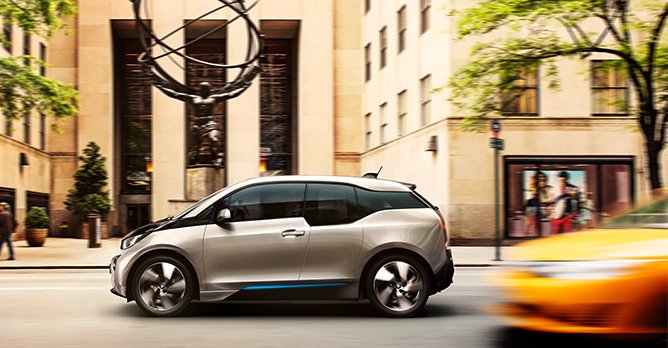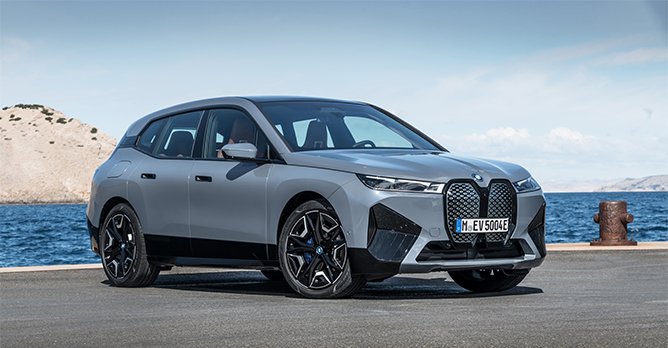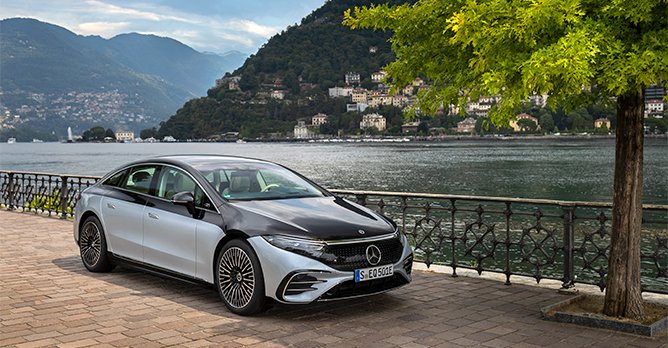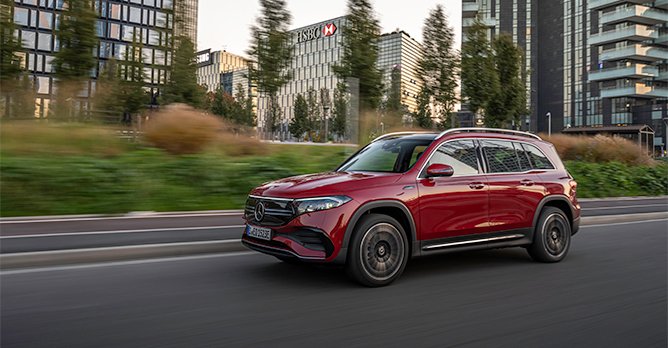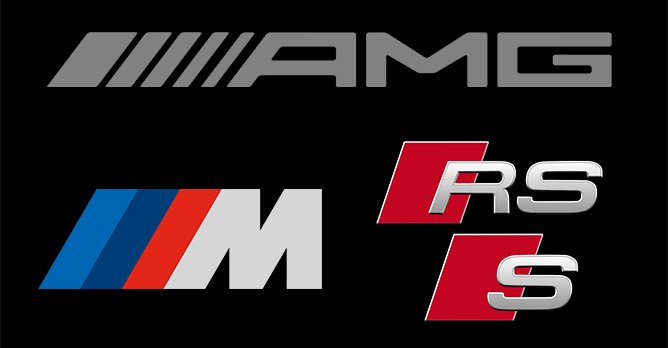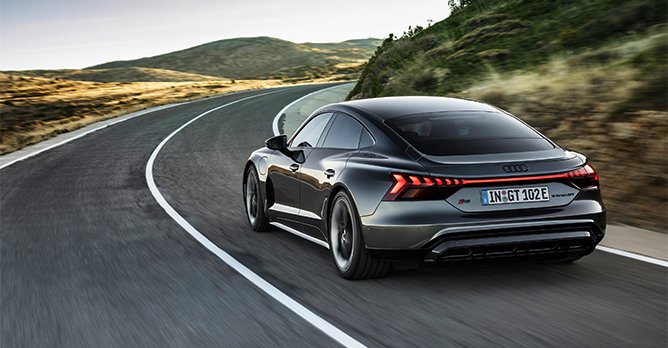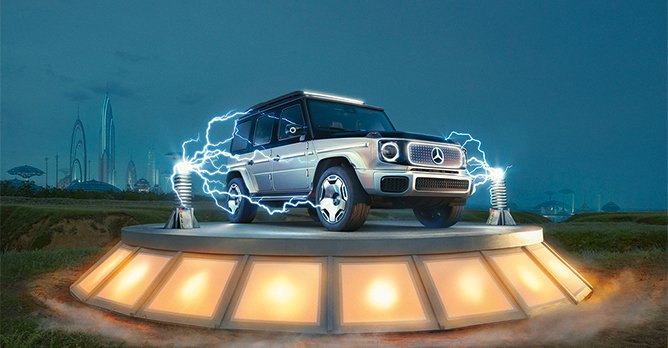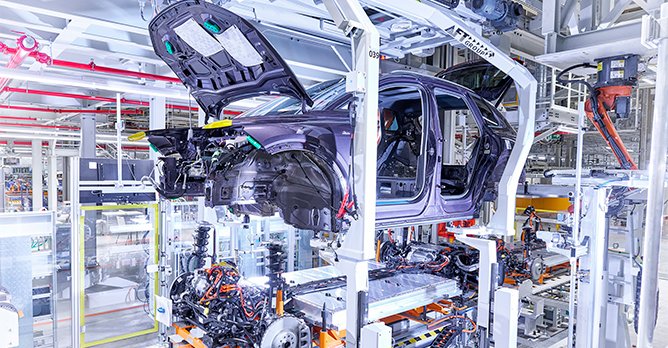Audi's e-tron, BMW's i, and Mercedes' EQ: How it started versus how it's going
17 Feb 2022|927 views
When one looks upon the automotive world of 2040, they will perhaps be able to separate the industry's names into two distinct groups.
There will be names which hadn't existed 50 years prior - companies which identified, then successfully seized electrification's new-fangled market opportunities to establish themselves. Then, there will also be persisting legacy carmakers - those who were light enough on their feet to have smoothly transitioned from combustion-engines to batteries.
With their Audi e-tron, BMW i, and Mercedes-EQ cars, it is the latter group that Germany's Big 3 are now fighting tooth and nail to spearhead.
Audi, BMW, and Mercedes-Benz, as the definitive examples of luxury car-making, have a longer modern history with electric cars than the casual observer might expect. Even so, the more important questions now are where they currently stand, and where they're headed next.
EVs of time past: Which production models helped to kick-start each of their journeys
There's no disputing BMW's historical crown for developing and selling EVs. While some brands are still in the midst of assembling a coherent EV strategy, 2021 marked the watershed delivery of the one-millionth electrified BMW.
Back in 2011, the Bavarian carmaker had already debuted its concept cars for the i3 and i8 (for context, the second-gen 1 Series was unveiled at the same motorshow), while confirming the birth of BMW i. Both cars would later start reaching customers in late 2013 - the i3, with a fully-electric drivetrain, and the i8, as a plug-in hybrid.
Surprisingly, though, the roots of Audi's production electric cars can also be traced back to roughly the same period. The idea of electric power had actually already debuted on Audi's 2009 e-tron supercar concept, but because it was too expensive to produce, it was never sold.
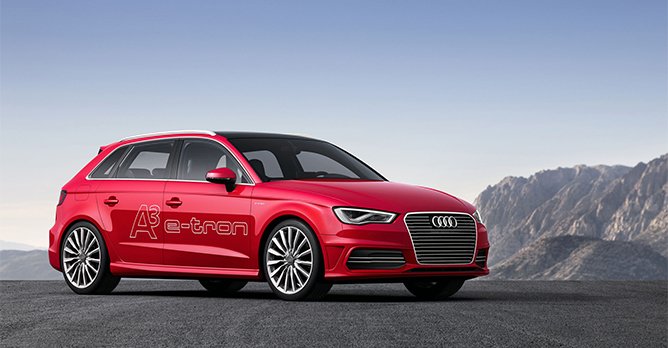
 The A3 Sportback e-tron was the first electrified production Audi, and had a 50km electric-only range Instead, the first electrified Audi that could actually be purchased was the 2013 A3 Sportback e-tron, a plug-in hybrid. This was followed up shortly after when the original e-tron vision was revived in 2015 with the second-gen R8. Fully-electric, the R8 e-tron boasted a 3.9 second sprint to 100km/h, but failed to gain traction once more due to its price tag.
The A3 Sportback e-tron was the first electrified production Audi, and had a 50km electric-only range Instead, the first electrified Audi that could actually be purchased was the 2013 A3 Sportback e-tron, a plug-in hybrid. This was followed up shortly after when the original e-tron vision was revived in 2015 with the second-gen R8. Fully-electric, the R8 e-tron boasted a 3.9 second sprint to 100km/h, but failed to gain traction once more due to its price tag.
Merc's history stretches back even further. Even though Mercedes-EQ only came into being in 2016, Daimler Group was already pushing out fuel-cell vehicles (well... a different type of electric) in the early 2000s.
In 2010, some semblances of production-ready EVs then started to come together through the A-Class E-Cell (fully electric) and B-Class E-Cell Plus (a plug-in hybrid). Both, however, were released in limited numbers.
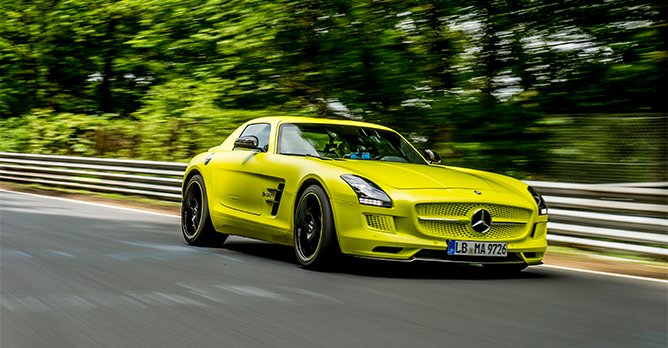
 With a more than USD$500,000 price tag - four times that of the 6.2-litre V8 in 2009 - the SLS AMG Electric Drive also sold less than 100 units The E-Cell naming convention underwent a slight transformation thereafter.
With a more than USD$500,000 price tag - four times that of the 6.2-litre V8 in 2009 - the SLS AMG Electric Drive also sold less than 100 units The E-Cell naming convention underwent a slight transformation thereafter.
After debuting an SLS AMG E-Cell prototype in 2011, a 2013 SLS AMG Electric Drive variant marked the gull-winged supercar's most powerful iteration, with its four electric motors producing an incredible 740 hp and 1000Nm of torque.
Finally, in 2015, the second-gen B-Class was also given the Electric Drive treatment, boasting a sub-200km real-world range from a 28kWh battery.
A fun fact to note is that through it all, an up-and-coming name at that point had partnered Daimler Group on the development of the cars' drivetrains and battery packs: Tesla.
Choose your modern fighter: Different takes on the first flagship for the modern electric era
Even with BMW's full-committal early on, it may help to think of all the cars in the previous section as launched when EVs were still in beta mode; more 'good to have' than 'must-have'.
As they say, however, the times are changing. Under the weight of shifting regulations, industry prognoses estimate that EVs will constitute 50% of all new car sales by 2030.
Therein lies a huge challenge for legacy carmakers. The runway to producing EVs with bespoke platforms is long, complex and expensive. The runway to winning drivers over in a rapidly transforming market, contrarily, is very short.
To straddle this divide, a quicker, less taxing strategy has presented itself for the interim: Of reworking the architecture of existing combustion-engine cars to house electric drivetrains.
Distinguishing bespoke EVs from non-bespoke ones - despite both being fully-electric - is important in assessing where each of the Big 3 is placing first emphasis.
We could certainly suggest that the BMW iX3 is a better-made electric SUV than the Mercedes-Benz EQC - or some will argue perhaps, vice versa. But where we should be focusing our attention now is on the flagships.

 Audi has led the pack this time: Both the e-tron SUV (pictured) and GT debuted before the iX and EQS With the e-tron GT (and its RS version) Audi is putting its money with a grand tourer; BMW appears to be betting big on SUVs with its iX; whereas with the EQS, Mercedes-Benz has returned to its roots within the full-sized luxury sedan segment. As fully-bespoke EVs, these are the real stars of the modern era, packed full of all the tech and 'best-of' titles each maker is eager to showcase.
Audi has led the pack this time: Both the e-tron SUV (pictured) and GT debuted before the iX and EQS With the e-tron GT (and its RS version) Audi is putting its money with a grand tourer; BMW appears to be betting big on SUVs with its iX; whereas with the EQS, Mercedes-Benz has returned to its roots within the full-sized luxury sedan segment. As fully-bespoke EVs, these are the real stars of the modern era, packed full of all the tech and 'best-of' titles each maker is eager to showcase.
In fact, considering things as such, it would appear that Audi has actually taken the lead this time round. The e-tron SUV has been around since late 2018, but it was only early last year that BMW's iX and Merc's EQS followed, both after the world premiere of the Audi e-tron GT.
A critical lens to examine their strategies thus far
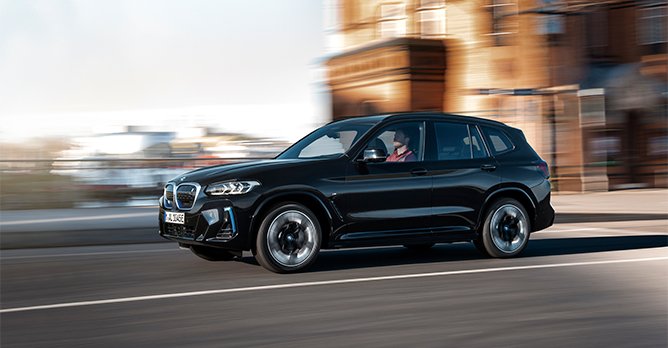
 The iX3 has pulled in solid numbers for a luxury EV, helping to breathe new life into BMW's EV lineup There's no denying the strides that the German carmakers have made in their switch to EVs.
The iX3 has pulled in solid numbers for a luxury EV, helping to breathe new life into BMW's EV lineup There's no denying the strides that the German carmakers have made in their switch to EVs.
On top of the i3 reaching more than 28,000 customers in its eighth full year of release, 2021 saw the BMW iX3 selling 38,000 units - impressive for a single model. Merc also delivered nearly 49,000 EQ branded vehicles worldwide without the EQS properly out yet. Audi was then the indubitable champion among the three, selling close to 82,000 BEVs.
Here, however, is where we step back to evaluate the smudges that have invariably tainted their performance thus far.

 In terms of sales, none of the German EVs still come close to Tesla's Model 3 and Model Y (pictured) To begin, none of them commands a position near the top of any EV sales chart. Combining figures, for context, from BMW Group and Mercedes-Benz Group together with Audi's (that brings in MINI, Rolls-Royce and SMART) won't even garner a third of what Tesla managed to deliver in 2021.
In terms of sales, none of the German EVs still come close to Tesla's Model 3 and Model Y (pictured) To begin, none of them commands a position near the top of any EV sales chart. Combining figures, for context, from BMW Group and Mercedes-Benz Group together with Audi's (that brings in MINI, Rolls-Royce and SMART) won't even garner a third of what Tesla managed to deliver in 2021.
There are other criticisms too. Audi's faster pivot to EVs, industry-experts will say, cannot be detached from the fallout of VW Group's massive Dieselgate scandal as it raced to minimise its association with diesel engines.
With a massive seven year-gap punctuating the releases of the i3 and iX3, it's also hard not to wonder where the i division would be today if BMW had doubled down on its electrification efforts a bit earlier. After all, few, if none, had the buzz it drummed up in the mid-2010s.
And as BMW once was the clear leader of the beta era, Merc is now arguably the current era's laggard among the three. It can lay claim to having the most fully-electric models, but actually offers the least bespoke ones currently.
Getting serious about electrification
A large part of adoration for all three brands is not just built on their synonymy with luxury, but on their illustrious history and thus, unparalleled know-how in the realm of car-making.
Most notably, they have been revered, protective guardians of the combustion engine; relentlessly fine-tuning it through their deep involvement in motorsports, and with the sort of sharp engineering and fastidious precision matched perhaps only by the Japanese.
Inevitable as it may be, leaving such a prized possession behind is undoubtedly painful. This may explain why their goodbyes have been so drawn out - and why they've slipped up, atypically, in their punctuality.
Now, however, their new flagships are here - with the sort of typical pizazz that we have grown accustomed to expecting.
Whether it's creating a full-fat, unforgettable electric sports car that doesn't fade into the crowd of torquey, century sprint-shredding EVs; deepening their sustainability efforts while putting on a remarkable showcase of tech both on the inside and out; or putting the Toyota Prius' aerodynamics to shame - the Germans have it all well covered.
Truthfully, there really isn't an objective way of saying which flagship strategy will work best. (We will note, however, that Merc has done something the others haven't by taking its ultimate emblem, the S-Class, and re-imagining - or e-imagining it. The 3 Series, for example, remains untouched as yet).
What we can be certain about, however, is the fact that even if the Germans have all been late with their follow-up RSVPs to the electric party, they're now making their second comings heard very loudly.
Game on: What's next
The next couple of years will see a whole avalanche of new EVs rolling down to us from the high heavens of German production lines.
The i4, developed in conjunction with the 4 Series Gran Coupe, was launched shortly before the iX and is slowly reaching customers worldwide. BMW has announced BEV models of the X1 and 5 Series, while testing for the i7 - an electrified 7 Series - has begun.
The EQE, already unveiled by Merc, will also start to make its way into new homes, with the EQS SUV and an all-but-confirmed production EQG (an electric G-Wagon!) in tow.
Audi, meanwhile, will soon debut the Q6 e-tron, even as the all-new Q4 e-tron and Q4 e-tron Sportback continue their steady (and remarkable) roll-out.
All of the Big 3 have also committed to a full electrification at some point. By 2023, fully-electric Bimmers will reside in 90% of BMW's market segments; Merc is aiming to do the same for all of its market segments this year. Both have lofty targets for the numbers that their electric cars will perform.
Audi, once again, is upping the stakes further; all of its new models launched post-2026 will be exclusively electric. While Merc has declared a similar all-electric target by 2030, like BMW, it's also leaving some breathing room for markets slower to the switch. Audi, instead, has pledged to cease production of its ICE (internal combustion engine) models by 2033 completely. That's only about 10 years from now.
It will be unrealistic to claim there isn't a lot of catching up that the Germans have to do with their keyrivals rival - in terms of the market share for EVs least.
But by throwing their best hats in the ring a bit earlier than many other legacy carmakers, they've at least gotten things going.
We're quite sure we'll be seeing them around in 2040.
There will be names which hadn't existed 50 years prior - companies which identified, then successfully seized electrification's new-fangled market opportunities to establish themselves. Then, there will also be persisting legacy carmakers - those who were light enough on their feet to have smoothly transitioned from combustion-engines to batteries.
With their Audi e-tron, BMW i, and Mercedes-EQ cars, it is the latter group that Germany's Big 3 are now fighting tooth and nail to spearhead.
Audi, BMW, and Mercedes-Benz, as the definitive examples of luxury car-making, have a longer modern history with electric cars than the casual observer might expect. Even so, the more important questions now are where they currently stand, and where they're headed next.
EVs of time past: Which production models helped to kick-start each of their journeys
There's no disputing BMW's historical crown for developing and selling EVs. While some brands are still in the midst of assembling a coherent EV strategy, 2021 marked the watershed delivery of the one-millionth electrified BMW.
Back in 2011, the Bavarian carmaker had already debuted its concept cars for the i3 and i8 (for context, the second-gen 1 Series was unveiled at the same motorshow), while confirming the birth of BMW i. Both cars would later start reaching customers in late 2013 - the i3, with a fully-electric drivetrain, and the i8, as a plug-in hybrid.
Surprisingly, though, the roots of Audi's production electric cars can also be traced back to roughly the same period. The idea of electric power had actually already debuted on Audi's 2009 e-tron supercar concept, but because it was too expensive to produce, it was never sold.

Merc's history stretches back even further. Even though Mercedes-EQ only came into being in 2016, Daimler Group was already pushing out fuel-cell vehicles (well... a different type of electric) in the early 2000s.
In 2010, some semblances of production-ready EVs then started to come together through the A-Class E-Cell (fully electric) and B-Class E-Cell Plus (a plug-in hybrid). Both, however, were released in limited numbers.

After debuting an SLS AMG E-Cell prototype in 2011, a 2013 SLS AMG Electric Drive variant marked the gull-winged supercar's most powerful iteration, with its four electric motors producing an incredible 740 hp and 1000Nm of torque.
Finally, in 2015, the second-gen B-Class was also given the Electric Drive treatment, boasting a sub-200km real-world range from a 28kWh battery.
A fun fact to note is that through it all, an up-and-coming name at that point had partnered Daimler Group on the development of the cars' drivetrains and battery packs: Tesla.
Choose your modern fighter: Different takes on the first flagship for the modern electric era
Even with BMW's full-committal early on, it may help to think of all the cars in the previous section as launched when EVs were still in beta mode; more 'good to have' than 'must-have'.
As they say, however, the times are changing. Under the weight of shifting regulations, industry prognoses estimate that EVs will constitute 50% of all new car sales by 2030.
Therein lies a huge challenge for legacy carmakers. The runway to producing EVs with bespoke platforms is long, complex and expensive. The runway to winning drivers over in a rapidly transforming market, contrarily, is very short.
To straddle this divide, a quicker, less taxing strategy has presented itself for the interim: Of reworking the architecture of existing combustion-engine cars to house electric drivetrains.
Distinguishing bespoke EVs from non-bespoke ones - despite both being fully-electric - is important in assessing where each of the Big 3 is placing first emphasis.
We could certainly suggest that the BMW iX3 is a better-made electric SUV than the Mercedes-Benz EQC - or some will argue perhaps, vice versa. But where we should be focusing our attention now is on the flagships.

In fact, considering things as such, it would appear that Audi has actually taken the lead this time round. The e-tron SUV has been around since late 2018, but it was only early last year that BMW's iX and Merc's EQS followed, both after the world premiere of the Audi e-tron GT.
A critical lens to examine their strategies thus far

On top of the i3 reaching more than 28,000 customers in its eighth full year of release, 2021 saw the BMW iX3 selling 38,000 units - impressive for a single model. Merc also delivered nearly 49,000 EQ branded vehicles worldwide without the EQS properly out yet. Audi was then the indubitable champion among the three, selling close to 82,000 BEVs.
Here, however, is where we step back to evaluate the smudges that have invariably tainted their performance thus far.

There are other criticisms too. Audi's faster pivot to EVs, industry-experts will say, cannot be detached from the fallout of VW Group's massive Dieselgate scandal as it raced to minimise its association with diesel engines.
With a massive seven year-gap punctuating the releases of the i3 and iX3, it's also hard not to wonder where the i division would be today if BMW had doubled down on its electrification efforts a bit earlier. After all, few, if none, had the buzz it drummed up in the mid-2010s.
And as BMW once was the clear leader of the beta era, Merc is now arguably the current era's laggard among the three. It can lay claim to having the most fully-electric models, but actually offers the least bespoke ones currently.
Getting serious about electrification
A large part of adoration for all three brands is not just built on their synonymy with luxury, but on their illustrious history and thus, unparalleled know-how in the realm of car-making.
Most notably, they have been revered, protective guardians of the combustion engine; relentlessly fine-tuning it through their deep involvement in motorsports, and with the sort of sharp engineering and fastidious precision matched perhaps only by the Japanese.
Inevitable as it may be, leaving such a prized possession behind is undoubtedly painful. This may explain why their goodbyes have been so drawn out - and why they've slipped up, atypically, in their punctuality.
Now, however, their new flagships are here - with the sort of typical pizazz that we have grown accustomed to expecting.
Whether it's creating a full-fat, unforgettable electric sports car that doesn't fade into the crowd of torquey, century sprint-shredding EVs; deepening their sustainability efforts while putting on a remarkable showcase of tech both on the inside and out; or putting the Toyota Prius' aerodynamics to shame - the Germans have it all well covered.
Truthfully, there really isn't an objective way of saying which flagship strategy will work best. (We will note, however, that Merc has done something the others haven't by taking its ultimate emblem, the S-Class, and re-imagining - or e-imagining it. The 3 Series, for example, remains untouched as yet).
What we can be certain about, however, is the fact that even if the Germans have all been late with their follow-up RSVPs to the electric party, they're now making their second comings heard very loudly.
Game on: What's next
The next couple of years will see a whole avalanche of new EVs rolling down to us from the high heavens of German production lines.
The i4, developed in conjunction with the 4 Series Gran Coupe, was launched shortly before the iX and is slowly reaching customers worldwide. BMW has announced BEV models of the X1 and 5 Series, while testing for the i7 - an electrified 7 Series - has begun.
The EQE, already unveiled by Merc, will also start to make its way into new homes, with the EQS SUV and an all-but-confirmed production EQG (an electric G-Wagon!) in tow.
Audi, meanwhile, will soon debut the Q6 e-tron, even as the all-new Q4 e-tron and Q4 e-tron Sportback continue their steady (and remarkable) roll-out.
All of the Big 3 have also committed to a full electrification at some point. By 2023, fully-electric Bimmers will reside in 90% of BMW's market segments; Merc is aiming to do the same for all of its market segments this year. Both have lofty targets for the numbers that their electric cars will perform.
Audi, once again, is upping the stakes further; all of its new models launched post-2026 will be exclusively electric. While Merc has declared a similar all-electric target by 2030, like BMW, it's also leaving some breathing room for markets slower to the switch. Audi, instead, has pledged to cease production of its ICE (internal combustion engine) models by 2033 completely. That's only about 10 years from now.
It will be unrealistic to claim there isn't a lot of catching up that the Germans have to do with their key
But by throwing their best hats in the ring a bit earlier than many other legacy carmakers, they've at least gotten things going.
We're quite sure we'll be seeing them around in 2040.
When one looks upon the automotive world of 2040, they will perhaps be able to separate the industry's names into two distinct groups.
There will be names which hadn't existed 50 years prior - companies which identified, then successfully seized electrification's new-fangled market opportunities to establish themselves. Then, there will also be persisting legacy carmakers - those who were light enough on their feet to have smoothly transitioned from combustion-engines to batteries.
With their Audi e-tron, BMW i, and Mercedes-EQ cars, it is the latter group that Germany's Big 3 are now fighting tooth and nail to spearhead.
Audi, BMW, and Mercedes-Benz, as the definitive examples of luxury car-making, have a longer modern history with electric cars than the casual observer might expect. Even so, the more important questions now are where they currently stand, and where they're headed next.
EVs of time past: Which production models helped to kick-start each of their journeys
There's no disputing BMW's historical crown for developing and selling EVs. While some brands are still in the midst of assembling a coherent EV strategy, 2021 marked the watershed delivery of the one-millionth electrified BMW.
Back in 2011, the Bavarian carmaker had already debuted its concept cars for the i3 and i8 (for context, the second-gen 1 Series was unveiled at the same motorshow), while confirming the birth of BMW i. Both cars would later start reaching customers in late 2013 - the i3, with a fully-electric drivetrain, and the i8, as a plug-in hybrid.
Surprisingly, though, the roots of Audi's production electric cars can also be traced back to roughly the same period. The idea of electric power had actually already debuted on Audi's 2009 e-tron supercar concept, but because it was too expensive to produce, it was never sold.

 The A3 Sportback e-tron was the first electrified production Audi, and had a 50km electric-only range Instead, the first electrified Audi that could actually be purchased was the 2013 A3 Sportback e-tron, a plug-in hybrid. This was followed up shortly after when the original e-tron vision was revived in 2015 with the second-gen R8. Fully-electric, the R8 e-tron boasted a 3.9 second sprint to 100km/h, but failed to gain traction once more due to its price tag.
The A3 Sportback e-tron was the first electrified production Audi, and had a 50km electric-only range Instead, the first electrified Audi that could actually be purchased was the 2013 A3 Sportback e-tron, a plug-in hybrid. This was followed up shortly after when the original e-tron vision was revived in 2015 with the second-gen R8. Fully-electric, the R8 e-tron boasted a 3.9 second sprint to 100km/h, but failed to gain traction once more due to its price tag.
Merc's history stretches back even further. Even though Mercedes-EQ only came into being in 2016, Daimler Group was already pushing out fuel-cell vehicles (well... a different type of electric) in the early 2000s.
In 2010, some semblances of production-ready EVs then started to come together through the A-Class E-Cell (fully electric) and B-Class E-Cell Plus (a plug-in hybrid). Both, however, were released in limited numbers.


With a more than USD$500,000 price tag - four times that of the 6.2-litre V8 in 2009 - the SLS AMG Electric Drive also sold less than 100 units The E-Cell naming convention underwent a slight transformation thereafter.
After debuting an SLS AMG E-Cell prototype in 2011, a 2013 SLS AMG Electric Drive variant marked the gull-winged supercar's most powerful iteration, with its four electric motors producing an incredible 740 hp and 1000Nm of torque.
Finally, in 2015, the second-gen B-Class was also given the Electric Drive treatment, boasting a sub-200km real-world range from a 28kWh battery.
A fun fact to note is that through it all, an up-and-coming name at that point had partnered Daimler Group on the development of the cars' drivetrains and battery packs: Tesla.
Choose your modern fighter: Different takes on the first flagship for the modern electric era
Even with BMW's full-committal early on, it may help to think of all the cars in the previous section as launched when EVs were still in beta mode; more 'good to have' than 'must-have'.
As they say, however, the times are changing. Under the weight of shifting regulations, industry prognoses estimate that EVs will constitute 50% of all new car sales by 2030.
Therein lies a huge challenge for legacy carmakers. The runway to producing EVs with bespoke platforms is long, complex and expensive. The runway to winning drivers over in a rapidly transforming market, contrarily, is very short.
To straddle this divide, a quicker, less taxing strategy has presented itself for the interim: Of reworking the architecture of existing combustion-engine cars to house electric drivetrains.
Distinguishing bespoke EVs from non-bespoke ones - despite both being fully-electric - is important in assessing where each of the Big 3 is placing first emphasis.
We could certainly suggest that the BMW iX3 is a better-made electric SUV than the Mercedes-Benz EQC - or some will argue perhaps, vice versa. But where we should be focusing our attention now is on the flagships.

 Audi has led the pack this time: Both the e-tron SUV (pictured) and GT debuted before the iX and EQS With the e-tron GT (and its RS version) Audi is putting its money with a grand tourer; BMW appears to be betting big on SUVs with its iX; whereas with the EQS, Mercedes-Benz has returned to its roots within the full-sized luxury sedan segment. As fully-bespoke EVs, these are the real stars of the modern era, packed full of all the tech and 'best-of' titles each maker is eager to showcase.
Audi has led the pack this time: Both the e-tron SUV (pictured) and GT debuted before the iX and EQS With the e-tron GT (and its RS version) Audi is putting its money with a grand tourer; BMW appears to be betting big on SUVs with its iX; whereas with the EQS, Mercedes-Benz has returned to its roots within the full-sized luxury sedan segment. As fully-bespoke EVs, these are the real stars of the modern era, packed full of all the tech and 'best-of' titles each maker is eager to showcase.
In fact, considering things as such, it would appear that Audi has actually taken the lead this time round. The e-tron SUV has been around since late 2018, but it was only early last year that BMW's iX and Merc's EQS followed, both after the world premiere of the Audi e-tron GT.
A critical lens to examine their strategies thus far

 The iX3 has pulled in solid numbers for a luxury EV, helping to breathe new life into BMW's EV lineup There's no denying the strides that the German carmakers have made in their switch to EVs.
The iX3 has pulled in solid numbers for a luxury EV, helping to breathe new life into BMW's EV lineup There's no denying the strides that the German carmakers have made in their switch to EVs.
On top of the i3 reaching more than 28,000 customers in its eighth full year of release, 2021 saw the BMW iX3 selling 38,000 units - impressive for a single model. Merc also delivered nearly 49,000 EQ branded vehicles worldwide without the EQS properly out yet. Audi was then the indubitable champion among the three, selling close to 82,000 BEVs.
Here, however, is where we step back to evaluate the smudges that have invariably tainted their performance thus far.

 In terms of sales, none of the German EVs still come close to Tesla's Model 3 and Model Y (pictured) To begin, none of them commands a position near the top of any EV sales chart. Combining figures, for context, from BMW Group and Mercedes-Benz Group together with Audi's (that brings in MINI, Rolls-Royce and SMART) won't even garner a third of what Tesla managed to deliver in 2021.
In terms of sales, none of the German EVs still come close to Tesla's Model 3 and Model Y (pictured) To begin, none of them commands a position near the top of any EV sales chart. Combining figures, for context, from BMW Group and Mercedes-Benz Group together with Audi's (that brings in MINI, Rolls-Royce and SMART) won't even garner a third of what Tesla managed to deliver in 2021.
There are other criticisms too. Audi's faster pivot to EVs, industry-experts will say, cannot be detached from the fallout of VW Group's massive Dieselgate scandal as it raced to minimise its association with diesel engines.
With a massive seven year-gap punctuating the releases of the i3 and iX3, it's also hard not to wonder where the i division would be today if BMW had doubled down on its electrification efforts a bit earlier. After all, few, if none, had the buzz it drummed up in the mid-2010s.
And as BMW once was the clear leader of the beta era, Merc is now arguably the current era's laggard among the three. It can lay claim to having the most fully-electric models, but actually offers the least bespoke ones currently.
Getting serious about electrification
A large part of adoration for all three brands is not just built on their synonymy with luxury, but on their illustrious history and thus, unparalleled know-how in the realm of car-making.
Most notably, they have been revered, protective guardians of the combustion engine; relentlessly fine-tuning it through their deep involvement in motorsports, and with the sort of sharp engineering and fastidious precision matched perhaps only by the Japanese.
Inevitable as it may be, leaving such a prized possession behind is undoubtedly painful. This may explain why their goodbyes have been so drawn out - and why they've slipped up, atypically, in their punctuality.
Now, however, their new flagships are here - with the sort of typical pizazz that we have grown accustomed to expecting.
Whether it's creating a full-fat, unforgettable electric sports car that doesn't fade into the crowd of torquey, century sprint-shredding EVs; deepening their sustainability efforts while putting on a remarkable showcase of tech both on the inside and out; or putting the Toyota Prius' aerodynamics to shame - the Germans have it all well covered.
Truthfully, there really isn't an objective way of saying which flagship strategy will work best. (We will note, however, that Merc has done something the others haven't by taking its ultimate emblem, the S-Class, and re-imagining - or e-imagining it. The 3 Series, for example, remains untouched as yet).
What we can be certain about, however, is the fact that even if the Germans have all been late with their follow-up RSVPs to the electric party, they're now making their second comings heard very loudly.
Game on: What's next
The next couple of years will see a whole avalanche of new EVs rolling down to us from the high heavens of German production lines.
The i4, developed in conjunction with the 4 Series Gran Coupe, was launched shortly before the iX and is slowly reaching customers worldwide. BMW has announced BEV models of the X1 and 5 Series, while testing for the i7 - an electrified 7 Series - has begun.
The EQE, already unveiled by Merc, will also start to make its way into new homes, with the EQS SUV and an all-but-confirmed production EQG (an electric G-Wagon!) in tow.
Audi, meanwhile, will soon debut the Q6 e-tron, even as the all-new Q4 e-tron and Q4 e-tron Sportback continue their steady (and remarkable) roll-out.
All of the Big 3 have also committed to a full electrification at some point. By 2023, fully-electric Bimmers will reside in 90% of BMW's market segments; Merc is aiming to do the same for all of its market segments this year. Both have lofty targets for the numbers that their electric cars will perform.
Audi, once again, is upping the stakes further; all of its new models launched post-2026 will be exclusively electric. While Merc has declared a similar all-electric target by 2030, like BMW, it's also leaving some breathing room for markets slower to the switch. Audi, instead, has pledged to cease production of its ICE (internal combustion engine) models by 2033 completely. That's only about 10 years from now.
It will be unrealistic to claim there isn't a lot of catching up that the Germans have to do with their keyrivals rival - in terms of the market share for EVs least.
But by throwing their best hats in the ring a bit earlier than many other legacy carmakers, they've at least gotten things going.
We're quite sure we'll be seeing them around in 2040.
There will be names which hadn't existed 50 years prior - companies which identified, then successfully seized electrification's new-fangled market opportunities to establish themselves. Then, there will also be persisting legacy carmakers - those who were light enough on their feet to have smoothly transitioned from combustion-engines to batteries.
With their Audi e-tron, BMW i, and Mercedes-EQ cars, it is the latter group that Germany's Big 3 are now fighting tooth and nail to spearhead.
Audi, BMW, and Mercedes-Benz, as the definitive examples of luxury car-making, have a longer modern history with electric cars than the casual observer might expect. Even so, the more important questions now are where they currently stand, and where they're headed next.
EVs of time past: Which production models helped to kick-start each of their journeys
There's no disputing BMW's historical crown for developing and selling EVs. While some brands are still in the midst of assembling a coherent EV strategy, 2021 marked the watershed delivery of the one-millionth electrified BMW.
Back in 2011, the Bavarian carmaker had already debuted its concept cars for the i3 and i8 (for context, the second-gen 1 Series was unveiled at the same motorshow), while confirming the birth of BMW i. Both cars would later start reaching customers in late 2013 - the i3, with a fully-electric drivetrain, and the i8, as a plug-in hybrid.
Surprisingly, though, the roots of Audi's production electric cars can also be traced back to roughly the same period. The idea of electric power had actually already debuted on Audi's 2009 e-tron supercar concept, but because it was too expensive to produce, it was never sold.

Merc's history stretches back even further. Even though Mercedes-EQ only came into being in 2016, Daimler Group was already pushing out fuel-cell vehicles (well... a different type of electric) in the early 2000s.
In 2010, some semblances of production-ready EVs then started to come together through the A-Class E-Cell (fully electric) and B-Class E-Cell Plus (a plug-in hybrid). Both, however, were released in limited numbers.

With a more than USD$500,000 price tag - four times that of the 6.2-litre V8 in 2009 - the SLS AMG Electric Drive also sold less than 100 units
After debuting an SLS AMG E-Cell prototype in 2011, a 2013 SLS AMG Electric Drive variant marked the gull-winged supercar's most powerful iteration, with its four electric motors producing an incredible 740 hp and 1000Nm of torque.
Finally, in 2015, the second-gen B-Class was also given the Electric Drive treatment, boasting a sub-200km real-world range from a 28kWh battery.
A fun fact to note is that through it all, an up-and-coming name at that point had partnered Daimler Group on the development of the cars' drivetrains and battery packs: Tesla.
Choose your modern fighter: Different takes on the first flagship for the modern electric era
Even with BMW's full-committal early on, it may help to think of all the cars in the previous section as launched when EVs were still in beta mode; more 'good to have' than 'must-have'.
As they say, however, the times are changing. Under the weight of shifting regulations, industry prognoses estimate that EVs will constitute 50% of all new car sales by 2030.
Therein lies a huge challenge for legacy carmakers. The runway to producing EVs with bespoke platforms is long, complex and expensive. The runway to winning drivers over in a rapidly transforming market, contrarily, is very short.
To straddle this divide, a quicker, less taxing strategy has presented itself for the interim: Of reworking the architecture of existing combustion-engine cars to house electric drivetrains.
Distinguishing bespoke EVs from non-bespoke ones - despite both being fully-electric - is important in assessing where each of the Big 3 is placing first emphasis.
We could certainly suggest that the BMW iX3 is a better-made electric SUV than the Mercedes-Benz EQC - or some will argue perhaps, vice versa. But where we should be focusing our attention now is on the flagships.

In fact, considering things as such, it would appear that Audi has actually taken the lead this time round. The e-tron SUV has been around since late 2018, but it was only early last year that BMW's iX and Merc's EQS followed, both after the world premiere of the Audi e-tron GT.
A critical lens to examine their strategies thus far

On top of the i3 reaching more than 28,000 customers in its eighth full year of release, 2021 saw the BMW iX3 selling 38,000 units - impressive for a single model. Merc also delivered nearly 49,000 EQ branded vehicles worldwide without the EQS properly out yet. Audi was then the indubitable champion among the three, selling close to 82,000 BEVs.
Here, however, is where we step back to evaluate the smudges that have invariably tainted their performance thus far.

There are other criticisms too. Audi's faster pivot to EVs, industry-experts will say, cannot be detached from the fallout of VW Group's massive Dieselgate scandal as it raced to minimise its association with diesel engines.
With a massive seven year-gap punctuating the releases of the i3 and iX3, it's also hard not to wonder where the i division would be today if BMW had doubled down on its electrification efforts a bit earlier. After all, few, if none, had the buzz it drummed up in the mid-2010s.
And as BMW once was the clear leader of the beta era, Merc is now arguably the current era's laggard among the three. It can lay claim to having the most fully-electric models, but actually offers the least bespoke ones currently.
Getting serious about electrification
A large part of adoration for all three brands is not just built on their synonymy with luxury, but on their illustrious history and thus, unparalleled know-how in the realm of car-making.
Most notably, they have been revered, protective guardians of the combustion engine; relentlessly fine-tuning it through their deep involvement in motorsports, and with the sort of sharp engineering and fastidious precision matched perhaps only by the Japanese.
Inevitable as it may be, leaving such a prized possession behind is undoubtedly painful. This may explain why their goodbyes have been so drawn out - and why they've slipped up, atypically, in their punctuality.
Now, however, their new flagships are here - with the sort of typical pizazz that we have grown accustomed to expecting.
Whether it's creating a full-fat, unforgettable electric sports car that doesn't fade into the crowd of torquey, century sprint-shredding EVs; deepening their sustainability efforts while putting on a remarkable showcase of tech both on the inside and out; or putting the Toyota Prius' aerodynamics to shame - the Germans have it all well covered.
Truthfully, there really isn't an objective way of saying which flagship strategy will work best. (We will note, however, that Merc has done something the others haven't by taking its ultimate emblem, the S-Class, and re-imagining - or e-imagining it. The 3 Series, for example, remains untouched as yet).
What we can be certain about, however, is the fact that even if the Germans have all been late with their follow-up RSVPs to the electric party, they're now making their second comings heard very loudly.
Game on: What's next
The next couple of years will see a whole avalanche of new EVs rolling down to us from the high heavens of German production lines.
The i4, developed in conjunction with the 4 Series Gran Coupe, was launched shortly before the iX and is slowly reaching customers worldwide. BMW has announced BEV models of the X1 and 5 Series, while testing for the i7 - an electrified 7 Series - has begun.
The EQE, already unveiled by Merc, will also start to make its way into new homes, with the EQS SUV and an all-but-confirmed production EQG (an electric G-Wagon!) in tow.
Audi, meanwhile, will soon debut the Q6 e-tron, even as the all-new Q4 e-tron and Q4 e-tron Sportback continue their steady (and remarkable) roll-out.
All of the Big 3 have also committed to a full electrification at some point. By 2023, fully-electric Bimmers will reside in 90% of BMW's market segments; Merc is aiming to do the same for all of its market segments this year. Both have lofty targets for the numbers that their electric cars will perform.
Audi, once again, is upping the stakes further; all of its new models launched post-2026 will be exclusively electric. While Merc has declared a similar all-electric target by 2030, like BMW, it's also leaving some breathing room for markets slower to the switch. Audi, instead, has pledged to cease production of its ICE (internal combustion engine) models by 2033 completely. That's only about 10 years from now.
It will be unrealistic to claim there isn't a lot of catching up that the Germans have to do with their key
But by throwing their best hats in the ring a bit earlier than many other legacy carmakers, they've at least gotten things going.
We're quite sure we'll be seeing them around in 2040.
Thank You For Your Subscription.


















